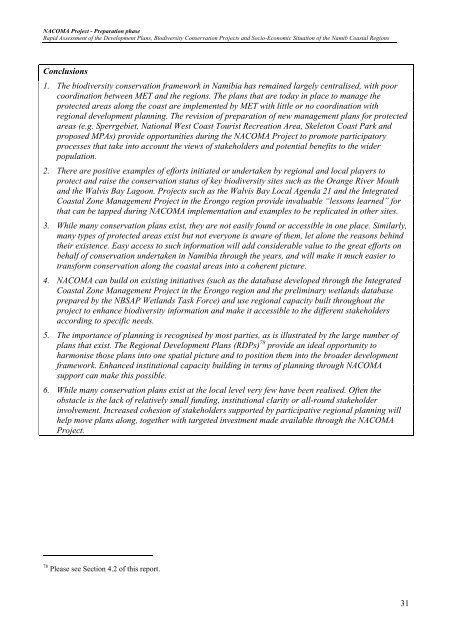Full report LR.pdf - DLIST Benguela
Full report LR.pdf - DLIST Benguela
Full report LR.pdf - DLIST Benguela
- No tags were found...
Create successful ePaper yourself
Turn your PDF publications into a flip-book with our unique Google optimized e-Paper software.
NACOMA Project - Preparation phaseRapid Assessment of the Development Plans, Biodiversity Conservation Projects and Socio-Economic Situation of the Namib Coastal RegionsConclusions1. The biodiversity conservation framework in Namibia has remained largely centralised, with poorcoordination between MET and the regions. The plans that are today in place to manage theprotected areas along the coast are implemented by MET with little or no coordination withregional development planning. The revision of preparation of new management plans for protectedareas (e.g. Sperrgebiet, National West Coast Tourist Recreation Area, Skeleton Coast Park andproposed MPAs) provide opportunities during the NACOMA Project to promote participatoryprocesses that take into account the views of stakeholders and potential benefits to the widerpopulation.2. There are positive examples of efforts initiated or undertaken by regional and local players toprotect and raise the conservation status of key biodiversity sites such as the Orange River Mouthand the Walvis Bay Lagoon. Projects such as the Walvis Bay Local Agenda 21 and the IntegratedCoastal Zone Management Project in the Erongo region provide invaluable “lessons learned” forthat can be tapped during NACOMA implementation and examples to be replicated in other sites.3. While many conservation plans exist, they are not easily found or accessible in one place. Similarly,many types of protected areas exist but not everyone is aware of them, let alone the reasons behindtheir existence. Easy access to such information will add considerable value to the great efforts onbehalf of conservation undertaken in Namibia through the years, and will make it much easier totransform conservation along the coastal areas into a coherent picture.4. NACOMA can build on existing initiatives (such as the database developed through the IntegratedCoastal Zone Management Project in the Erongo region and the preliminary wetlands databaseprepared by the NBSAP Wetlands Task Force) and use regional capacity built throughout theproject to enhance biodiversity information and make it accessible to the different stakeholdersaccording to specific needs.5. The importance of planning is recognised by most parties, as is illustrated by the large number ofplans that exist. The Regional Development Plans (RDPs) 78 provide an ideal opportunity toharmonise those plans into one spatial picture and to position them into the broader developmentframework. Enhanced institutional capacity building in terms of planning through NACOMAsupport can make this possible.6. While many conservation plans exist at the local level very few have been realised. Often theobstacle is the lack of relatively small funding, institutional clarity or all-round stakeholderinvolvement. Increased cohesion of stakeholders supported by participative regional planning willhelp move plans along, together with targeted investment made available through the NACOMAProject.78 Please see Section 4.2 of this <strong>report</strong>.31












